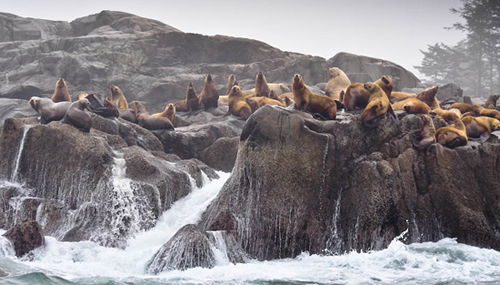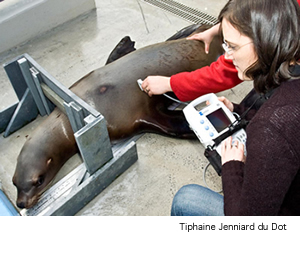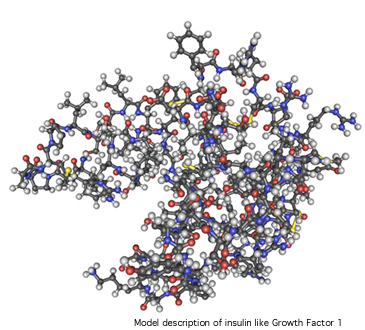
To land-dwellers, a sea lion’s life looks fairly uneventful: swim, eat, sleep and reproduce. In fact, a sea lion leads a rather dramatic life. Sea lions and all marine mammals, for that matter live in environments that are continuously changing, particularly with regards to food supply. An animal’s ability to respond to these changes determines whether or not it will live to swim, eat, sleep, and reproduce another day.
Survival largely depends on how the animal regulates energy intake and expenditure when times get tough. Fortunately, they can defer these decisions to a powerful internal headquarters: the endocrine system. This complex system of glands secretes hormones that regulate the body, influencing an animal’s physiological responses in times of food shortages.
 A team of Consortium researchers recently got to know the Steller sea lion’s endocrine system more intimately by finding out how hormone changes during periods of food shortage are influenced by an animal’s age, diet, and the season.
A team of Consortium researchers recently got to know the Steller sea lion’s endocrine system more intimately by finding out how hormone changes during periods of food shortage are influenced by an animal’s age, diet, and the season.
The research team comprised Tiphaine Jenniard du Dot, David Rosen, and Andrew Trites from the University of British Columbia Fisheries Centre; Julie P. Richmond from the University of Connecticut’s Department of Animal Science, and Alexander S. Kitaysky of the Institue of Arctic Biology (University of Alaska Fairbanks). Their study was published in Comparative Biochemistry and Physiology.
Honing in on hormones
The researchers focused on the three groups of hormones primarily involved in the endocrine response to nutritional stress: the somatotropic hormones including the insulin-like growth factor-1 (IGF-I), the thyroid hormones (T3 and T4), and glucocorticoids such as cortisol. They chose eight captive female Stellers (five three-year-olds and three five-year-olds), and reduced the animals’ food intake for significant periods in both summer and winter. One test group was given a smaller ration of its usual herring diet (a high-fat fish), while the other received a normal amount of fish but were switched to pollock (a low-fat, low-energy fish). After the test period, both groups returned to eating their normal herring regime.
 The researchers found that the Stellers’ levels of stress hormones (cortisol) and growth hormones (IGF-I) measured via blood samples changed as the animals lost and regained weight. In fact, they were able to link each hormone to a different strategy for preserving energy (lipid versus lean mass catabolism). Thyroid hormones, on the other hand, could not be linked to any physical changes they observed.
The researchers found that the Stellers’ levels of stress hormones (cortisol) and growth hormones (IGF-I) measured via blood samples changed as the animals lost and regained weight. In fact, they were able to link each hormone to a different strategy for preserving energy (lipid versus lean mass catabolism). Thyroid hormones, on the other hand, could not be linked to any physical changes they observed.
The researchers also found that young animals show greater hormone changes than their elders, and that the type of fish they received (high-energy or low-energy) made little difference on hormone levels.
Another step forward
The team concluded that studying a Steller sea lion’s cortisol and IGF-I levels could help them detect and better understand nutritional stress, as well as the energetic strategy animals use to cope with it. The study brought them yet another step closer to understanding how Steller sea lions cope with the unpredictable environments they call home.
SEE PUBLICATION:
|

|

 |
||||||||||||
